
PPC doesn’t have to be boring!
In the performance-driven world of paid search, it’s easy to forget how to be creative.
A fun, innovative, and well-executed PPC campaign can work wonders for your business.
We’ve researched and compiled the 10 of the most creative paid search campaigns of all time.
First Things First, What is PPC?
A PPC advertising campaign involves running online ads where you only pay when someone clicks on them. You can target specific keywords and demographics to reach potential customers.
PPC stands for pay-per-click. It’s a type of digital marketing where you only pay when someone clicks on your ad. This is a way to drive targeted traffic to your website or landing page.
Here’s a breakdown of how PPC works:
- You create an ad for your product or service.
- You choose where you want your ad to be shown, such as search engines, social media platforms, or websites.
- You bid on keywords that are relevant to your business.
- When someone searches for a keyword that you’ve bid on, your ad may appear in the search results.
- If someone clicks on your ad, you pay a fee.
There are many benefits to using PPC advertising, such as:
- It can help you reach a large audience quickly.
- You can target your ads to specific demographics and interests.
- You can track your results and see how well your ads are performing.
A quick example of a PPC ad
Here’s a pay-per-click example: You run a bakery and pay $1 each time someone clicks your ad for “chocolate chip cookies” on a search engine.
In this example, you’ve bid on the keyword “chocolate chip cookies.” This means you tell Google Ads the maximum amount you’re willing to pay each time someone clicks your ad that appears when someone searches for that term.
You can take things a step further by refining who sees your ad. PPC platforms allow you to target specific demographics or interests.
Remember that to get clicks you need to create a compelling ad that entices people. It might include a mouth-watering image of your cookies, highlight their unique selling points (like secret family recipe or award-winning), and mention a special offer (e.g., “Fresh-baked cookies! Get 10% off your first order“). You’ll also need to include a clear call to action, such as “Click to order now!“

1. Know Your Client Inside and Out: Develop a deep understanding of your client’s business, their goals, and what they offer. 2. Become the Client’s Client: Put yourself in the shoes of the client’s target audience. By understanding the client’s products or services from a user’s perspective, you can craft campaigns that truly resonate.
3. Utilize Psychology: Leverage psychological insights to create compelling ads that attract and engage users. When you understand both the client and their audience, your PPC campaigns become more relatable and effective.
4. Personal Touch: Ensure your marketing feels personal and not forced. Users are more likely to respond positively to campaigns that speak to them on a human level.
That being said, let’s look at some examples of top PPC ad campaigns.
1. Converse “Domaination”
This PPC campaign is one of our favourites. Converse, the global footwear brand, with the help of the marketing agency Anomoly took a novel and innovative way to connect with their teenage audience online. They really captured their target audience in a fun and creative way.

The agency used Google AdWords to tap into any given moment in culture by becoming relevant and fostering ‘converse-ations’, rather than selling their products directly.
They created a campaign that targeted search terms that their prospective customers might be searching for. A few examples of these are:
- [First day of summer]
- [Spelling bee]
- [How to talk to girls]
- [How to kiss]
Instead of presenting the viewer with an ad, Converse started a dialogue through the ad copy and multiple interconnected microsites that engaged the user in a deeper content-rich experience. It allows them to be there for their audience during cultural moments and its one long path that leads back to their brand.
Watch the full video here:
2. Snickers – You’re Not You When You’re Hungry
While it’s common practice in the PPC world to target misspelled search terms, Snickers took this to a whole new level. With the help of AMV BBDO ad agency and Google, they were able to obtain a list of the top 500 search terms. Then, using a clever algorithm, they generated a list of 25,381 different misspellings.
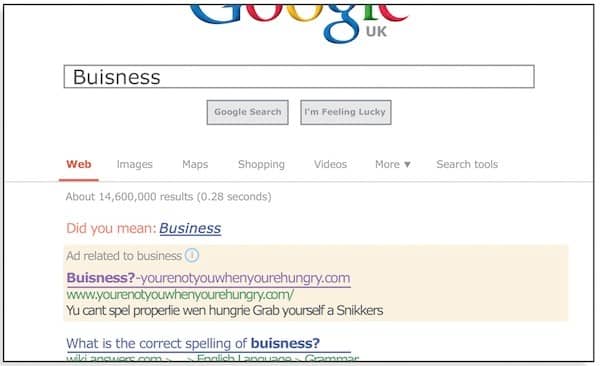
Jessica Langdell from AMV BBDO reveals the list of incorrect spellings that brought a surprising amount of traffic for this Snickers campaign.
- [wether]
- [gool]
- [ness]
- [amazin]
- [definately]
- [wierd]
- [vacum]
- [moonsoon]
- [publically]
- [facw]
In just two days Snickers reported 558,589 ad impressions. With a click-through rate of 1.05%, 5,874 visitors made their way to the campaigns mini website yourenotyouwhenyourehungry.com.
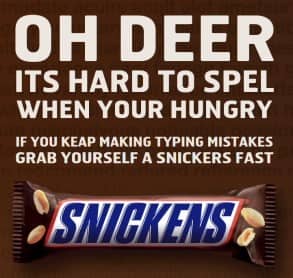
We are still not sure how the ad agency got Google to approve the campaign considering it’s against Google’s ad policies to run ads that do not use commonly accepted spelling and grammar. Hence, to be safe from this uncertainty, it’s important to proofread the ad content thoroughly. For this, you can use a grammar check facility, which allows you to look for mistakes and correct them in no time.
3. Kleenex Catches Colds
This campaign won the award for the “Best Use of Digital Media in 2013” and rightly so.
The ad experts at Mindshare developed a unique adaptive planning strategy. They realised when people get a cold or flu they turn to Google, not a doctor.
This insight into a fundamental change in consumer behaviour allowed Mindshare to use Google to geographically target cities nationally with flu outbreaks, in real-time. Thus allowing them to focus the PPC campaign where it was relevant.
For 18 months, Mindshare analysed search trends related to colds and flu and compared it to other data. This included calls to Government health lines and doctor visits. The model they built allowed them to predict relevant flu outbreaks, at the city level, in real-time.
How effective was it? In the 2012 cold and flu season, 96% of Kleenex UK’s media spend went to regions of the country suffering a live flu outbreak. Total sales increased by 40% year-on-year in the first two months.
That’s a staggering extra 432,499 boxes of tissues sold.
4. A Lesson in How to Get Your Dream Job by Using Paid Search
Back in the summer of 2009, senior copywriter Alec Brownstein decided he wanted a new job. He decided to target 5 creative directors and bid on their names on Google AdWords. Brownstein presumed that if he often searches his own name on Google than they would too and this would be his way of getting their attention – and he was right.
Since Alec was the only person bidding on the names of the five creative directors he wanted to work for, the average cost per click was just $0.13.
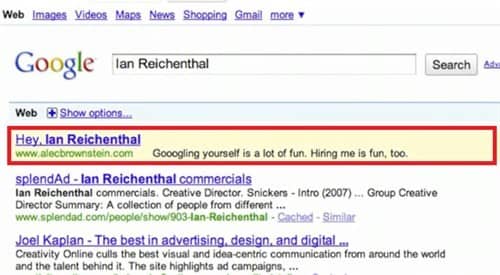
The ad, as shown above, linked to his website.
The result of the PPC campaign promoting himself? 4 out of the 5 directors he targeted gave him an interview and 2 of those 4 offered him a job. And the best part about this campaign is that it cost him a grand total of $6!
This really was a clever way to play on the vanity of some of New York City’s top creative directors.
You’re really tempted to Google your own name now, aren’t you?
5. The Infamous BP Oil Spill
Back in 2010, in an attempt to manage their brand reputation, BP decided to cap the gallons of bad publicity via the use of paid ads. They bid on over 1000 search terms related to “oil spill” and ranked in position 1 for most of them. This allowed them to direct users to a dedicated page on their website called “Gulf of Mexico Response homepage” and explain what they were doing to rectify the ocean disaster.
Here’s the ad in action:
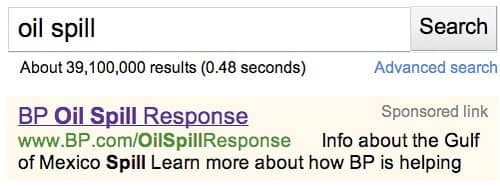
Genius right?
Well not quite… BP got their tone of voice completely wrong. Instead of talking to the users on a human level, I can only assume they got their finest lawyers to write an industry jargon-filled sentence to confuse the hell out of everyone.
They missed their opportunity to appeal to the public on a personal level.
At Digivate, we have a comprehensive process of identifying your target audience using our unique persona research.
Help me with personalised marketing
We think this was a combination of some media person not quite fully understanding PPC and feeling the need to jump on the BP hate bandwagon. According to ClickZ Expert Kevin Lee, it is estimated that BP spent almost $1 million in less than a month with the average cost per click being $1.33. This is a perfect example of a good initial idea but poor execution.
6. Ann Summers – Sexy Paid Search
A string of bold Ann Summers PPC campaigns that won the Revolution Awards in 2011 managed by iCrossing, saw them use an innovative way of using paid search as a branding tool.

Their strategy was to increase brand awareness. They tapped into current events by bidding on popular news-related search terms. Combine this with some cheeky brand-related ad copy and you’ve got yourself an award-winning PPC campaign.
Doesn’t sound too difficult to pull off, does it?
Here are a few examples of the news-related events iCrossing bid on:
2010 Election

British Airways Christmas Strike 2009
2011 Chinese New Year
This video by iCrossing sums up the Ann Summers PPC campaign pretty well.
Not only were the ads shown over 1.5 million times, but the campaigns were also picked up by the mainstream press. The BBC, The Guardian, and The Independent all wrote about Ann Summers’ paid search campaigns.
All of this brand exposure cost them just £4,500.
The campaigns worked so well because the strategic decision to use these intrepid ads tied in perfectly with the Ann Summers brand image.
7. Sky News
Sky News had the challenge of using paid search to target users who searched for specific news stories. To get ahead of their competition, Sky News collaborated with Unique Digital, who took its RSS feed and ran it through their Darwin Optimiser technology. This created keywords that were highly relevant to particular news stories.
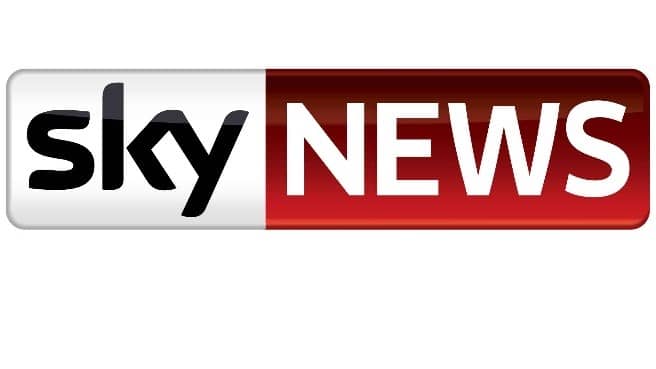
A pre-devised PPC budget was in place, which allowed the spend to be reviewed daily in the event of a major news story.
Why did this work?
The keywords are highly specific, which means that costs per click were low. Click volumes totaled over 100,000 clicks, whilst CPCs were priced under 25p each.
8. The Perfume Shop
The Perfume Shop used the fact that they sell celebrity perfumes to push their ads onto celebrity videos on YouTube for 6 months. Net Media Planet used its Mercury platform technology to bring the relevancy of paid search to display advertising. They targeted videos of celebrities who have their own fragrance brands – such as Sarah Jessica Parker, Beyoncé, and Peter Andre.
The Perfume Shop teamed up with Net Media Planet with the objective to use PPC to increase brand awareness and saliency for The Perfume Shop whilst generating sales of specific branded fragrances.
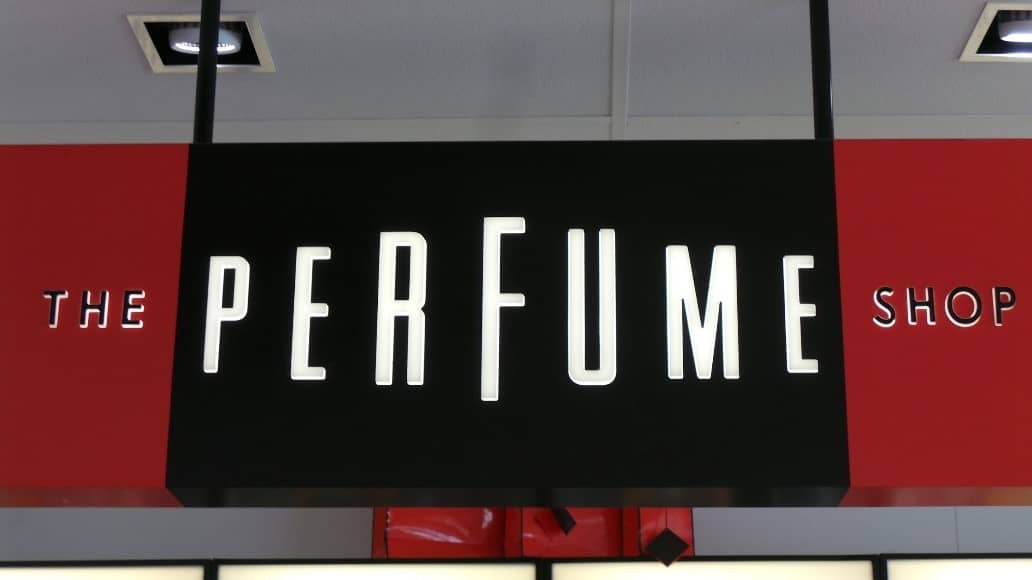
They received over 9 million views from the ads and gained a 236% ROI from the campaign.
9. Argos – Predictive Analytics in Performance Marketing
The winner of the best PPC campaign from the Search Awards 2014 saw Argos team up with Summit, a company who specialises in online marketing for retail clients.
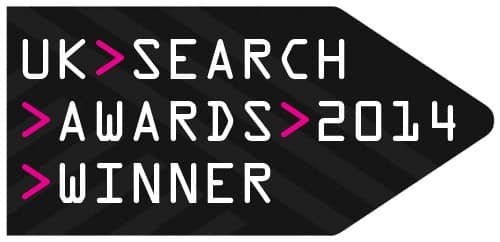
What set Summit apart from the other shortlisted entries was the use of predictive analytics to predict how customers would behave and adjust bids and ads in near real-time.
To increase the accuracy of these predictions Summit used data from sources such as weather, TV, location, and seasonality. This strategy saw Argos achieve new records in sales from PPC while keeping the costs down.
10. The Guy Who Used Facebook Ads to Get a Date – Matt Simpson
On April 2nd, 2011 Matt Simpson launch a Facebook ad campaign with the sole purpose of finding himself his ideal woman.
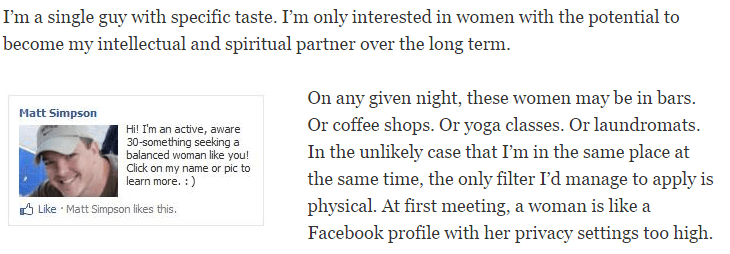
How did he do it?
Mr. Simpson took full advantage of Facebook’s audience targeting options. Mr. Simpson created ad parameters to target single women aged between 28 and 34. Their interests would include; yoga, meditation, and books by spiritual authors.
He also demographically targeted them to be within 25 miles of his hometown.
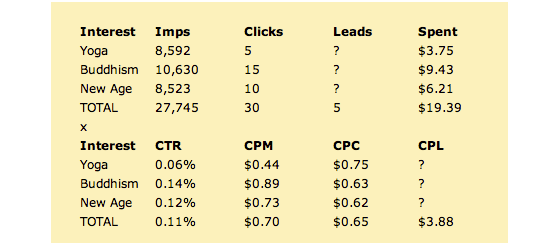
Mr. Simpson then created a Facebook fan page with a free contact form. In 5 days, his campaign drove 30 clicks and 5 leads via the contact form for $19.39. That’s just $3.88 per lead!
Wrapping Up
We hope you feel inspired or at least entertained by this collection of creative PPC campaigns.
The world of PPC advertising offers a powerful tool for businesses to reach their target audience with precision. By understanding the different campaign types, crafting compelling ad copy, and meticulously tracking results, you can unlock the true potential of PPC.
Remember, the “best” campaign is the one that aligns perfectly with your business goals, whether it’s driving brand awareness, generating leads, or boosting sales. With careful planning, continuous optimisation, and a data-driven approach, you can transform PPC advertising into a strategic asset that fuels your business growth. So, go forth, experiment, refine, and watch your PPC campaigns blossom into success stories!






